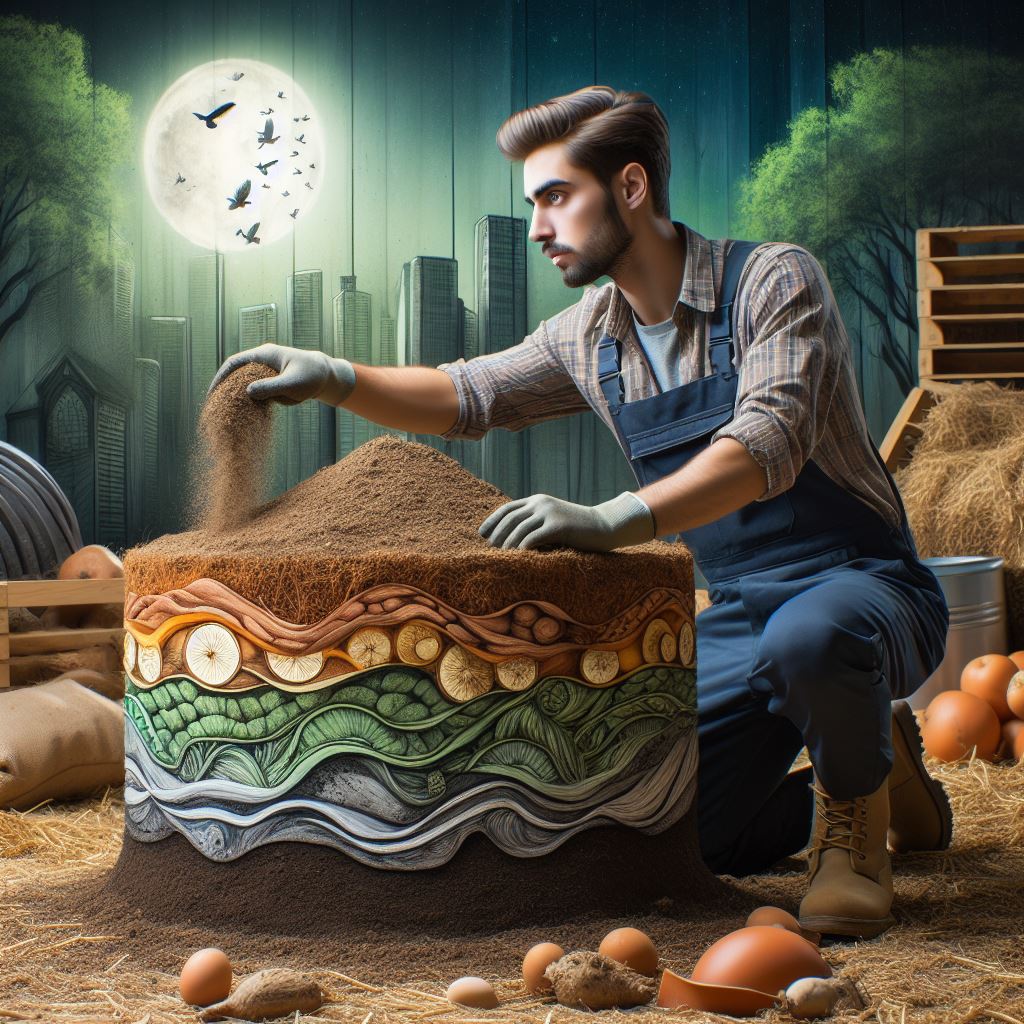Introduction
Compost making is a process of converting organic waste into nutrient-rich soil
Composting is a method of transforming organic waste into nutrient-rich soil, which can be used to enhance the growth of plants and improve soil quality.
One essential aspect of this process is layering, also known as lasagna gardening or sheet composting.
Layering refers to the systematic arrangement of different types of organic materials in order to facilitate the decomposition process and maintain a balanced nutrient composition in the finished compost.
Layering in composting is crucial for the decomposition and nutrient balance of the materials used
The importance of layering in compost making cannot be overstated.
By layering different materials, such as kitchen scraps, grass clippings, leaves, and twigs, composters can create the ideal conditions for decomposition.
Each layer serves a specific purpose in the overall composting process.
For instance, the bottom layer of coarse materials, such as twigs and branches, helps with aeration and drainage, preventing the pile from becoming too compact and wet.
This is crucial as proper airflow and moisture control are key factors in achieving successful composting.
As the layers are added, the varying components provide a rich source of carbon and nitrogen, which are essential for the organisms responsible for breaking down the organic matter.
The carbon-rich materials, often referred to as “browns,” include dried leaves, straw, and cardboard, while the nitrogen-rich materials, known as “greens,” consist of fresh grass clippings, fruit and vegetable scraps, and coffee grounds.
By layering these materials alternately, composters create a balanced carbon-to-nitrogen ratio, ensuring optimal microbial activity.
In short, layering plays a vital role in the art of compost making.
By carefully arranging the organic materials in a systematic manner, composters facilitate the decomposition process and maintain a balanced nutrient composition in the finished compost.
Understanding and mastering the art of layering can greatly enhance the effectiveness and efficiency of composting efforts.
What is compost layering
The concept of layering in compost making
Compost layering is the process of adding different materials in specific layers to create a balanced and nutrient-rich compost pile.
The purpose of layering in compost piles
The purpose of layering in compost piles is to promote decomposition and create a favorable environment for microorganisms to break down organic matter.
The benefits of layering for nutrient balance and decomposition
- Nutrient balance: Layering different materials ensures a diverse mix of nutrients in the compost pile, which leads to a well-balanced end product.
- Decomposition: The layers create an optimum ratio of carbon-rich materials (e.g., dry leaves, straw) and nitrogen-rich materials (e.g., kitchen scraps, grass clippings). This balance accelerates decomposition.
How to layer compost effectively
List the materials needed for compost layering
- Carbon-rich materials: Dry leaves, straw, shredded paper, cardboard.
- Nitrogen-rich materials: Vegetable scraps, grass clippings, coffee grounds, fresh weeds.
- Optional materials: Wood chips, crushed eggshells, garden soil.
Step-by-step guide for layering compost
- Start with a layer of carbon-rich materials, about 6-8 inches thick, as the base.
- Add a layer of nitrogen-rich materials, about 2-3 inches thick, on top of the carbon layer.
- Continue alternating these layers until you reach the desired height, ensuring a ratio of 3 parts carbon to 1 part nitrogen.
- Water each layer lightly to maintain moisture levels.
- Optionally add wood chips or crushed eggshells for improved aeration and nutrient content.
- Finish with a layer of garden soil to introduce beneficial microorganisms.
The importance of maintaining layer thickness and moisture levels
- Layer thickness: Maintaining the appropriate thickness of each layer ensures the right balance of carbon and nitrogen, promoting decomposition.
- Moisture levels: Adequate moisture is essential for microbial activity, so maintaining proper moisture throughout the pile is crucial.
Common mistakes to avoid in compost layering
Common mistakes in compost layering
- Heavy reliance on one material type, resulting in nutrient imbalances.
- Excessive layer thickness, leading to poor aeration and slower decomposition.
- Inadequate moisture, inhibiting microbial activity and compost breakdown.
The consequences of these mistakes
- Nutrient imbalances can result in a low-quality compost lacking essential elements.
- Poor aeration slows down decomposition, prolonging the composting process.
- Insufficient moisture slows or halts microbial action, slowing down the composting process as well.
Tips to avoid these mistakes
- Use a variety of carbon-rich and nitrogen-rich materials to ensure nutrient balance.
- Maintain layer thickness around 6-8 inches to allow proper aeration.
- Regularly check the moisture levels and add water if necessary to keep the pile moist but not waterlogged.
In general, compost layering is an essential technique in compost making as it promotes nutrient balance and decomposition.
By following the proper layering process and avoiding common mistakes, you can create high-quality compost that enriches your soil and benefits your plants.
Happy composting!
Understanding the compost layers
Different layers involved in compost-making
Understanding the different layers involved in compost making is essential for successful composting.
Each layer serves a specific purpose and contributes to the overall decomposition process.
The carbon-rich or “browns” layer
The carbon-rich or “browns” layer consists of materials like dried leaves, straw, twigs, and woodchips.
It provides a source of carbon, essential for microbial activity and helps regulate temperature and moisture.
The nitrogen-rich or “greens” layer
The nitrogen-rich or “greens” layer includes grass clippings, vegetable scraps, and fresh garden waste.
This layer supplies nitrogen, accelerates decomposition, and increases the nutrient content of the compost.
The water and moisture management layer
The water and moisture management layer ensures proper moisture levels throughout the pile.
It prevents the compost from drying out or becoming overly wet, which could hinder microbial activity.
Adequate moisture is crucial for the growth of microorganisms.
The oxygen and aeration layer
Finally, the oxygen and aeration layer allow oxygen to penetrate the compost pile, creating an aerobic environment.
This layer enables the breakdown of organic matter and helps prevent foul odors.
Techniques like regular turning or mixing of the compost facilitate aeration.
By understanding the purpose and characteristics of each layer, compost makers can adjust their composting process to achieve optimal results.
Consistently maintaining these layers will lead to the production of high-quality compost.
Composting, ultimately, becomes an art form, as compost makers artfully layer and balance ingredients to create a nutrient-rich, earthy substance that improves soil health and supports sustainable gardening practices.
Read: Garden Tool Safety: What You Need to Know
The Art of Balancing Compost Layers
The Importance of Balancing the Compost Layers
The proper balance of compost layers is crucial for successful composting.
Tips for Achieving the Right Balance
Using the Correct Ratio of Browns to Greens
Transform Your Agribusiness
Unlock your farm's potential with expert advice tailored to your needs. Get actionable steps that drive real results.
Get StartedMaintaining a balance between carbon-rich browns (such as dried leaves, twigs, and straw) and nitrogen-rich greens (such as vegetable scraps and grass clippings) is essential.
Aim for a ratio of approximately 3 parts browns to 1 part greens to ensure proper decomposition.
Considering Moisture and Watering Techniques
Moisture is necessary for the composting process, so ensure your compost pile is adequately moist but not too wet.
Regularly check the moisture level and adjust by adding water or dry materials accordingly.
Ensuring Proper Aeration and Oxygen Flow
Oxygen is crucial for the decomposition of organic matter.
Turn or aerate your compost pile regularly to provide oxygen to the microorganisms responsible for breaking down the materials.
Use a pitchfork or a compost turner to ensure even distribution of air throughout the pile.
Potential Challenges and How to Overcome Them
Composting may face a few challenges, but with the right approach, they can be overcome.
Odor
If your compost pile emits an unpleasant odor, it could be due to an imbalance of materials.
Add more brown materials to absorb excess moisture and increase aeration to help eliminate the smell.
Pests and Critters
To deter pests and critters, avoid adding meat, dairy products, and oily materials to your compost pile.
Use a compost bin with a secure lid or fence it to prevent animals from accessing it.
Slow Decomposition
If your compost is not decomposing as quickly as desired, check the moisture and aeration levels.
Adjust as necessary by adding water and turning the pile more frequently.
You can also shred the materials into smaller pieces to speed up the decomposition process.
By balancing compost layers properly, you create an optimal environment for microbial activity and achieve nutrient-rich compost for gardening or other uses.
Read: Must-Have Tools for Fruit & Veggie Gardens

Layering techniques for effective composting
There are various layering techniques that can be used in compost making.
These techniques not only help in breaking down organic matter efficiently, but also aid in creating a well-balanced compost.
Present different layering techniques used in compost making
- Lasagna composting: This technique involves layering different organic materials like greens, browns, and kitchen scraps to create a compost pile.
- Indirect layering method: In this method, the materials are layered in a separate pile and then added to the compost pile.
- Direct layering method: As the name suggests, the materials are directly layered into the compost pile without any pre-separation.
The benefits and suitability of each technique
Each layering technique has its own benefits and suitability based on the available resources and the desired outcome of the composting process.
Lasagna composting
Benefits:
Allows for better aeration and decomposition due to the alternating layers of greens and browns.
Provides a balanced mix of carbon and nitrogen, which is crucial for successful composting.
Ideal for small-scale composting and limited space as it can be done in a bin or even a trench.
Suitability:
Suitable for beginners as it is easy to understand and implement.
Works well with a wide range of materials such as grass clippings, leaves, and vegetable scraps.
Can be practiced throughout the year and in various climates.
Indirect layering method
Benefits:
Allows for better control over the composting process as materials can be pre-mixed and added in specific ratios.
Reduces the risk of attracting pests and odors, as the initial decomposition occurs in a separate pile.
Helps in managing specific compost needs, such as creating a high-nitrogen or high-carbon compost.
Suitability:
Showcase Your Farming Business
Publish your professional farming services profile on our blog for a one-time fee of $200 and reach a dedicated audience of farmers and agribusiness owners.
Publish Your ProfileIdeal for individuals who have specific requirements or limited access to certain materials.
Works well when a larger amount of compost needs to be produced.
Requires more upfront preparation and additional space for the separate pile.
Direct layering method
Benefits:
Saves time and effort as materials can be added directly to the compost pile without any additional steps.
Allows for continuous composting, as materials can be added as they become available.
Requires less space compared to the indirect method, as there is no need for a separate pile.
Suitability:
Ideal for individuals with limited space or those who want to start composting without much preparation.
Works well when there is a continuous supply of organic materials that need to be composted.
May not be suitable for those aiming for precise ratios of carbon and nitrogen in the compost.
In a nutshell, understanding the different layering techniques for compost making can greatly enhance the effectiveness of the composting process.
Whether it’s the lasagna composting method, indirect layering method, or direct layering method, each technique offers unique benefits and suitability depending on individual needs and resources.
Experimenting with these layering techniques can lead to the production of nutrient-rich compost for healthier plants and a greener environment.
Read: Choosing Tools for Hydroponic Gardening
You Might Also Like: Essential Soil Management Tools Explained
Examples of effective compost layering
Compost layering is an art that can transform kitchen and garden waste into nutrient-rich soil amendments.
By understanding the examples of effective compost layering, we can replicate successful outcomes and enjoy the benefits.
Let’s explore some real-life examples, discuss their outcomes, and offer insights on how readers can replicate similar results in their own composting endeavors.
Real-life examples of successful compost layering
- In a small compost bin, a gardener layered kitchen scraps, dried leaves, and grass clippings. This combination provided a perfect balance of carbon and nitrogen.
- Another successful example involved a compost pile made of garden waste, shredded newspaper, and chicken manure. This layering method ensured a diverse mix of organic materials.
Outcomes and benefits of these examples
- The compost bin with kitchen scraps, leaves, and grass clippings produced rich, dark compost within just four months. This nutrient-rich compost added valuable organic matter to the soil, enhancing plant growth.
- Similarly, the compost pile with garden waste, newspaper, and chicken manure proved highly effective. The layering method helped maintain moisture levels, eliminated weed seeds through proper heat generation, and resulted in premium-quality compost.
Insight into replicating similar results
- To replicate the success of the first example, start by collecting kitchen scraps regularly. Add them to the compost bin, alternating with dried leaves and grass clippings. This layering technique optimizes the carbon-to-nitrogen ratio and promotes decomposition.
- For the second example, gather garden waste such as leaves, stems, and pruned branches. Shred newspaper into thin strips and mix it with the garden waste. Additionally, incorporate chicken manure to provide a nitrogen boost. Turn and moisten the pile regularly to encourage microbial activity and achieve excellent composting results.
By following these real-life examples and understanding their outcomes and benefits, readers can incorporate similar compost layering methods in their own gardening practices.
Whether using a compost bin or pile, focusing on the right mix of organic materials and the correct layering technique can significantly enhance the decomposition process.
The result is nutrient-rich compost that improves soil fertility, supports plant growth, and reduces reliance on synthetic fertilizers.
In fact, compost layering is an essential component of successful composting.
The examples provided demonstrate the efficacy of specific layering methods in generating high-quality compost.
By replicating these examples, gardeners can create their own thriving compost systems, enrich their soil with nutrient-dense organic matter, and contribute to more sustainable gardening practices.
So, let’s embrace the art of layering in compost making and unlock the benefits it offers for our gardens and the environment.
Read: Container Gardening Tools for Urbanites
Troubleshooting common layering issues
Address common problems that can arise during compost layering
While compost layering is a straightforward process, it can encounter various challenges that impede the decomposition process, resulting in less effective compost.
Troubleshooting tips and solutions for these issues.
1. Foul odors
Foul odors in the compost heap can be caused by anaerobic conditions or improper layering.
- Ensure proper aeration by turning the compost regularly and adding coarse materials like twigs.
- Avoid adding large quantities of high-nitrogen materials at once, as it can create a strong odor.
- Consider adding organic matter with high carbon content, such as dry leaves or straw, to offset the odor.
- If the odor persists, adjust the moisture level by adding dry materials or watering if it’s too dry.
2. Slow decomposition
Slow decomposition can occur due to inappropriate layering, lack of moisture, or insufficient nitrogen.
- Check the moisture level of the compost; it should be moist like a wrung-out sponge.
- If the compost is too dry, dampen it with water. If it’s too wet, add dry materials to absorb excess moisture.
- Make sure you have a balance of materials high in nitrogen (green waste) and carbon (brown waste).
- If the compost lacks nitrogen, add nitrogen-rich materials like grass clippings or kitchen scraps.
- Avoid adding large pieces of woody material that take longer to decompose and may slow down the process.
3. Imbalanced nutrient levels
An imbalanced nutrient composition can lead to poor compost quality.
- Test the compost for nutrient content. Use a soil testing kit or send a sample to a lab for analysis.
- If the compost lacks essential nutrients, amend it by adding specific materials like bone meal or blood meal.
- Avoid excessive reliance on a single type of organic matter; diversify the materials for a broader nutrient profile.
- Layer the compost with a variety of ingredients, including kitchen scraps, yard waste, and garden debris.
- Consider using compost activators, like compost tea or commercial compost starters, to boost nutrient levels.
By addressing common layering issues and troubleshooting them effectively, you can ensure successful composting and achieve a nutrient-rich end product for your garden or plants.
Remember to monitor the compost pile regularly, maintain proper moisture levels, and balance the input of organic materials to promote efficient decomposition.
With a little patience and attention to detail, composting can be a rewarding and sustainable practice.
Conclusion
Recap the importance and benefits of layering in compost making
The importance and benefits of layering in compost making cannot be overstated.
By carefully alternating layers of green (nitrogen-rich) and brown (carbon-rich) materials, gardeners can create a dynamic environment that encourages microbial activity and accelerates the decomposition process.
This not only results in nutrient-rich compost but also helps to reduce waste by repurposing organic matter that would otherwise end up in landfills.
Additionally, properly layered compost provides a balanced mix of nutrients essential for healthy plant growth, thereby enriching the soil and promoting sustainable gardening practices.
Encouragement to experiment with layering techniques
As you embark on your composting journey, I encourage you to experiment with different layering techniques to find what works best for you and your specific composting setup.
Consider varying the thickness and composition of each layer, adjusting the moisture levels, and incorporating aeration methods to fine-tune the decomposition process.
By exploring various approaches to layering, you can discover the most effective combination of ingredients and methods to produce high-quality compost tailored to your gardening needs.
Provide a call-to-action for readers to share their experiences with compost layering
Finally, I invite you to join the conversation and share your experiences with compost layering.
Whether you’re a seasoned gardener with years of composting expertise or just starting out on your green thumb journey, your insights and observations can inspire and educate others in the community.
By exchanging tips, tricks, and success stories, we can collectively advance our understanding of composting techniques and promote eco-friendly gardening practices on a larger scale.
So, don’t hesitate to reach out, ask questions, and contribute to the ongoing dialogue about the art of layering in compost making.
Together, let’s nurture our planet and cultivate a greener, more sustainable future for generations to come.




